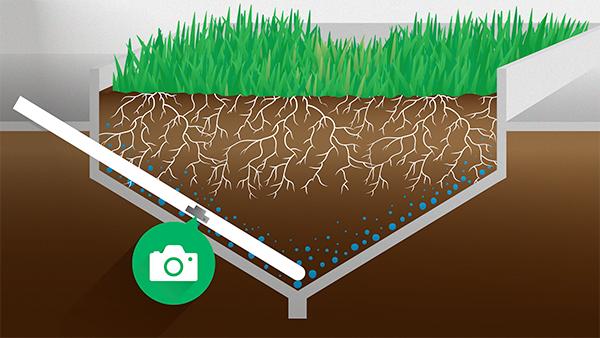 The global king of lawn seed has been investigating how to help drought-ridden lawns survive the summer with super-strength, deep rooting grass varieties
The global king of lawn seed has been investigating how to help drought-ridden lawns survive the summer with super-strength, deep rooting grass varieties
Lockdown has helped millions of Brits fall back in love with gardening and with the new work from home trend here to stay for many people, the state of the nation’s gardens has never been a hotter topic.
Whilst the average householder or gardener tends to judge the state of their lawn by making a quick assessment of surface conditions, most of us don’t have a clue what goes on beneath this top layer.
For Johnsons Lawn Seed, what lies beneath is the subject of intense research and huge investment. As part of the ground-breaking RadiMax project*, the global market leaders in lawn seed have pulled out all the stops to develop new crops with deeper roots that will perform better in a world that’s likely to experience more frequent droughts.
‘Drought!’ – we hear you cry – surely Great Britain is the rain capital of the world for much of the year? It can indeed seem that way, but according to the Environment Agency, England’s anticipated demand for water will exceed its supply by the year 2045. In 2019 there were particularly low groundwater levels in 25 separate areas of England – the highest recorded number of drought-prone zones since records began in 2006.
Broadly speaking, there are two types of drought in northern Europe – spring and summer – both of which are occurring more frequently and can have a severe impact on the state of our lawns. In 2020 – and for the sixth year in a row – northern and parts of central Europe were, to various degrees, hit by spring and early summer droughts.
In a typical spring drought the top surface of the ground is dry but lower down around the plant roots water levels are fine; to cope with the spring drought conditions, root performance is key, but most species bred for northern European conditions are not adapted for this as spring drought did not used to be an issue in the past. In an English summer drought, which tends to be considerably more severe, the soil also dries out further down. Some varieties of grass are tolerant to both sorts of drought, whilst others are better equipped to deal with either spring or summer water shortages.
Consumer Manager for Johnsons Lawn Seed, Guy Jenkins, says: “Plant growth faces great challenges in the future. Climate change has already had an effect on agriculture, parklands,
and other areas of green turf grass. The need for robust, drought-tolerant crops and turf grasses has never been greater.
“We spend millions each year on research and development so we can identify the most suitable grasses for different sorts of lawns, capable of withstanding the extremes of British weather. This does not mean any kind of genetic modification, we’re far too eco-conscious for that, but we do carry out gene mapping of hundreds of thousands of cultivators to find the best varieties of grass for your lawns.”

Not only do drought-tolerant grasses have a vastly improved appearance during dry spells, they also reduce the need for water guzzling lawn sprinklers and rising household bills. Stronger, healthier grass lawns are also less prone to weed invasion and require less fertilizer.
“The RadiMax research scientists have selected grasses with the fastest root growth, the deepest roots and highest root mass. This has enabled them to identify a number of best in class varieties when it comes to drought tolerance,” Mr Jenkins adds.
RadiMax is a one-of-a-kind research project and facility launched in 2016. It is a collaborative efforts between Johnsons Lawn Seed parent company, DLF, three Danish universities, and three other partners. The project utilises four three metres deep, soil-filled V-shaped pits. The plants that grow on the surface of the pits receive irrigation from the bottom only, whilst mobile tents ensure that no rain falls on the crops during the drought tests.

Plants that grow in the middle of a pit will have to root down to three metres to reach water. Measuring the biomass above ground enables the scientists to get a very good indication of the root system below. All relevant plant materials are then analyzed to generate genomic selection models, which breeders use to predict rooting depth of new breeding material and later select the most drought-resistant varieties.
Find out more
To find out more about Johnsons Lawn Seed products please visit http://www.johnsonslawnseed.com/product-range.aspx
ENDS
Words: 747
For more information, interviews or images please contact:
Kimberley Hornby Tel: 07851610573 Email: kimberley@hornbywhitefootpr.co.uk

